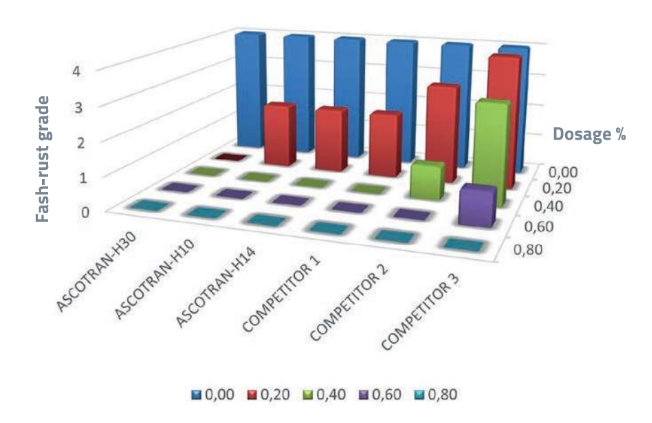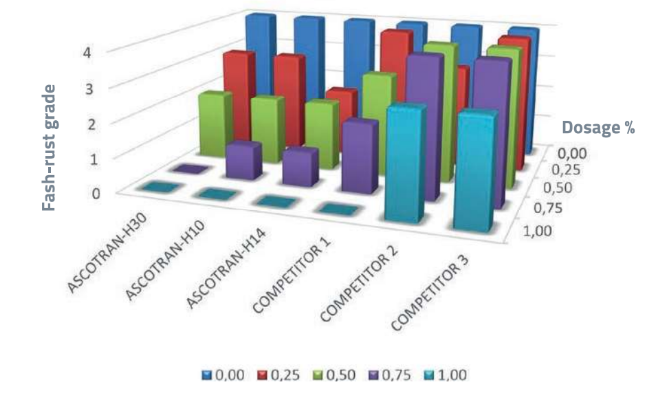Enhanced TDS
Identification & Functionality
- Carrier
- Chemical Family
- Chemical Name
- CASE Ingredients Functions
- Technologies
- Product Families
- Product Functions
- Ready-to-use, liquid-form antiflash-rust additive for any waterborne coating.
- Hydrophobic agent protecting the almost dry film under severe conditions of ambient humidity.
- Corrosion inhibitor for metal packaging protection.
- Chemical Nature
Aqueous preparation made of organic acid salts and azole derivatives. Contains less than 5% of sodium nitrite.
Features & Benefits
- Labeling Claims
- CASE Ingredients Features
- Product Features
- Ready-to-use aqueous liquid
- VOC-free
- Doesn’t lead to water sensitivity of the coating
- Usable in labeled (with a max dosage of 1%) paints
- Usable for ferrous and non-ferrous metals (aluminum, copper, zinc, brass)
- Compatible with a very wide range of binders (acrylics, stirene-acrylic, epoxy, PU, alkyds, …)
Applications & Uses
- Markets
- Applications
- Compatible Polymers & Resins
- Compatible Substrates & Surfaces
- Adhesive & Sealant End Applications
- Coating End Applications
- Dosage
- Can be added at any manufacturing step.
- Can be post-added.
- In 2K systems: should be added in the resin part in most cases (to be checked with preliminary testing).
- Indicative use dosages (% of total coating weight):
- 0.1 to 0.3% on degreased substrates, not rusted, sand-blasted or not.
- 0.3 to 1.0% on cast-iron or rusted substrates, on welds.
- 0.3 to 1.5% for packaging protection.
- Above dosages can be increased when the coating is applied in severe conditions of ambient humidity.
- General Formulation Guidelines
- Incorporation via pre- or post-addition possible
- Efficient mixing required
- Addition SIFLOC D below 80°C
- Addition of key fabric softener ingredients at a temperature that is not below the melting point of the softener active. The dye, preservative and fragrance ingredients are typically added at the end at a lower temperature.
- Typical incorporation levels:
- 0.1 to 0.5% product as supplied in fabric rinse conditioners
- 0.5 to 5.0% product as supplied in acidic cleaners
Properties
- Physical Form
- Appearance
- Pale yellow limpid liquid
- Miscible in
- Water, Ethanol, Ethylene glycol, Butylglycol, Dipropylene glycol methyl ether (up to 2%)
- Immiscible In
- Methyl ethyl ketone, Isopropanol
- Typical Properties
Value Units Test Method / Conditions Density (at 20°C) 1.12 - 1.16 - - pH Value (at 20°C, Pure) 7.5 - 8.1 Viscosity (at 20°C) max. 30 cPs - Freezing Point max. 0 °C - Volatile Organic Compounds 0 % 2004-42-CE
Regulatory & Compliance
- Certifications & Compliance
- Chemical Inventories
Technical Details & Test Data
- Antiflash - Rust Performance
ASCOTRAN® H14 additives provide highest levels of flash-rust inhibition at low use dosages. It outperform high nitrite-containing additives or usual flash-rust inhibitors, even when film dries under severe humidity conditions.
- Flash-rust comparative* test into a 1K Water-based Acrylic DTM Application on cold-rolled steel under normal drying conditions

- Flash-rust comparative* test into a 1K Water-based Acrylic DTM Application on sand-blasted cast-iron under severe drying conditions

Note - * COMPETITORS 1, 2 and 3 are high nitrite-content additives.
- Preserve Film Water Resistance
Whereas usual flash-rust inhibitors reduce coatings water-resistance, the ASCOTRAN® H14 technology combines excellent antiflash-rust performance with hydrophobic properties.
- WB 2K EPOXY PRIMER
- ASTM D870 (40°C) 250H, DFT 70 um, CRS
- Dosage in Flash-Rust Inhibitor: 0.5%

- WB 1K ACRYLIC PRIMER
- DFT - 70 um, GRIT BLASTED CAST-IRON DRYING 2H UNDER A CAP + at FREE RT
- Dosage in Flash-Rust Inhibitor : 1%

- Packaging Protection
Coatings can be highly corrosive and can cause, in most cases, corrosion of metallic cans which contain them. ASCOTRAN® flash-rust inhibitors also provide in-can protection.

- Mechanism Liquid Dispersion Polymers (LDP)
- A Liquid Dispersion Polymer is a dispersion of microparticles in a non-aqueous carrier phase and a non-ionic activating surfactant
- Upon addition to water, the activating surfactant emulsifies the carrier phase and water swells the polymer particle by osmosis
- The apparent viscosity depends on the amount of available water and the osmotic pressure
Packaging & Availability
- Packaging Type
- Supplied by
- Packaging Information
- Plastic pail of 30kg net.
- Metal drum of 200kg net.
- IBC of 1000 kg net.
Transport
Weight and packaging size (off-pallet) :- Pail: 1,5kg - Ø30, H50
- Drum: 15kg - Ø60, H90
- IBC: 70kg - L120, l100, H120
Storage & Handling
- Shelf Life
- 2 years
- Storage Conditions
- Ideal temperature conditions: 0 to 30°C.
- Exposure: avoid direct exposure to sunlight.
- With time, the color of the product may turn darker, but it doesn’t modify its properties.
